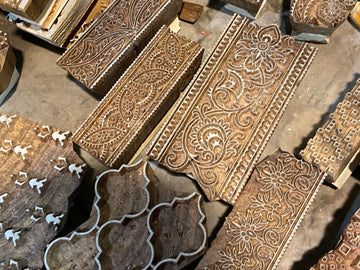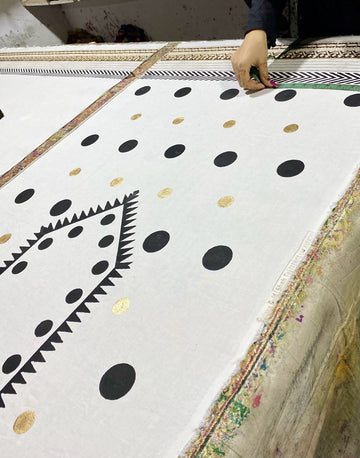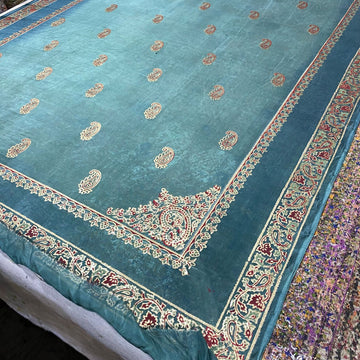Block printing is a fascinating and intricate process that transforms plain fabrics into vibrant works of art. This age-old technique involves using carved wooden blocks, natural dyes, and meticulous craftsmanship to create unique patterns and designs. Each piece tells a story, reflecting the heritage and skills of the artisans who bring it to life. In this blog, we’ll take you behind the scenes to explore the step-by-step process of block printing and highlight what makes each piece truly special.
1. Designing the Pattern: Crafting the Wooden Blocks
The journey of block printing begins with the design process. Skilled artisans, often referred to as block makers, carefully carve intricate patterns onto wooden blocks. These blocks are traditionally made from durable woods like teak or sheesham to ensure longevity and precision.
-
Creating the Motif: Each block is carefully chiseled by hand to form motifs that range from floral and geometric patterns to more elaborate scenes inspired by nature or cultural heritage. The design is first drawn on paper and then transferred onto the wooden block, which is carved with great attention to detail.
-
Layered Patterns: For multi-colored designs, separate blocks are created for each color, ensuring that they fit together seamlessly like pieces of a puzzle. This is known as registration, a technique that allows for perfect alignment when printing multiple colors.

2. Preparing the Fabric: Setting the Canvas
Once the blocks are ready, the next step is to prepare the fabric. The type of fabric used for block printing can vary, but natural fibers like cotton, linen, and silk are the most common. Proper fabric preparation is crucial to ensure that the dyes adhere well and the colors remain vibrant.
-
Washing and Bleaching: The fabric is first washed and bleached to remove any impurities and ensure a clean, white canvas for the prints. This step helps the fabric absorb the dye evenly.
-
Starching and Drying: To prevent the fabric from shifting during the printing process, it is starched and dried, making it stiffer and easier to work with.

3. Mixing the Colors: Preparing Natural Dyes
One of the key elements that make block printed fabrics stand out is the use of natural dyes. These dyes are made from plant-based sources like indigo, turmeric, and pomegranate, as well as mineral and metal oxides.
-
Creating the Dye Paste: The dyes are mixed with water and a binding agent to create a thick paste. Each dye has a unique preparation process to ensure the right consistency and color intensity. Natural ingredients, such as gum arabic or rice paste, may be added to the dye to increase its adherence to the fabric.
-
Testing the Colors: Before the actual printing, artisans test the colors on small fabric samples to see how they interact with the material and ensure the desired shades are achieved.

4. Printing the Fabric: Bringing the Design to Life
With the fabric and dyes ready, it’s time for the main event—printing the design. This step requires precision, patience, and experience to ensure the final product is flawless.
-
Dipping the Block: The wooden block is dipped into the dye paste and pressed onto the fabric with firm, even pressure. Artisans often use a small cushion under the fabric to help distribute the pressure evenly and achieve a crisp, clear print.
-
Aligning the Patterns: If the design involves multiple colors or repeating motifs, the artisan must align each block perfectly to avoid any gaps or overlaps. This step is crucial and requires a keen eye for detail.
-
Repeating the Process: The process is repeated methodically across the length and width of the fabric until the entire surface is covered with the desired pattern.

5. Drying and Setting the Colors: Locking in the Beauty
Once the fabric is printed, it is left to dry in a shaded area to preserve the vibrancy of the colors. Direct sunlight can cause the colors to fade prematurely, so it’s important to let the fabric dry in a controlled environment.
-
Heat Setting: To ensure the colors are long-lasting and don’t wash out, the fabric is heat set. This can be done using a traditional iron or by steaming, depending on the type of fabric and dyes used.
-
Washing and Finishing: The fabric is then washed again to remove any excess dye and starch, giving it a softer feel. It is dried and finished to ensure there are no wrinkles or irregularities.

6. Final Quality Check: Ensuring Perfection
Before the fabric is deemed ready, it undergoes a thorough quality check. Artisans carefully inspect each piece for consistency in the print, alignment of patterns, and any imperfections. Only the highest quality pieces pass this rigorous inspection and are then prepared for final packaging.
The Beauty of Block Printing: A Celebration of Art and Craftsmanship
Block printing is much more than just a method of decorating fabric—it’s a celebration of traditional craftsmanship, passed down through generations. Every piece of block printed fabric carries with it the labor of love, the skill of experienced hands, and the beauty of time-honored techniques.
When you choose block printed garments or home décor, you’re not just choosing a product—you’re choosing a piece of history, a work of art that reflects the heritage and dedication of artisans who keep this craft alive.
So, the next time you wear or decorate your home with a block printed piece, take a moment to appreciate the intricate journey it has taken to reach you. From the first chisel on the wooden block to the final quality check, each step in the process adds a layer of authenticity and charm, making block printed fabrics truly one-of-a-kind.




